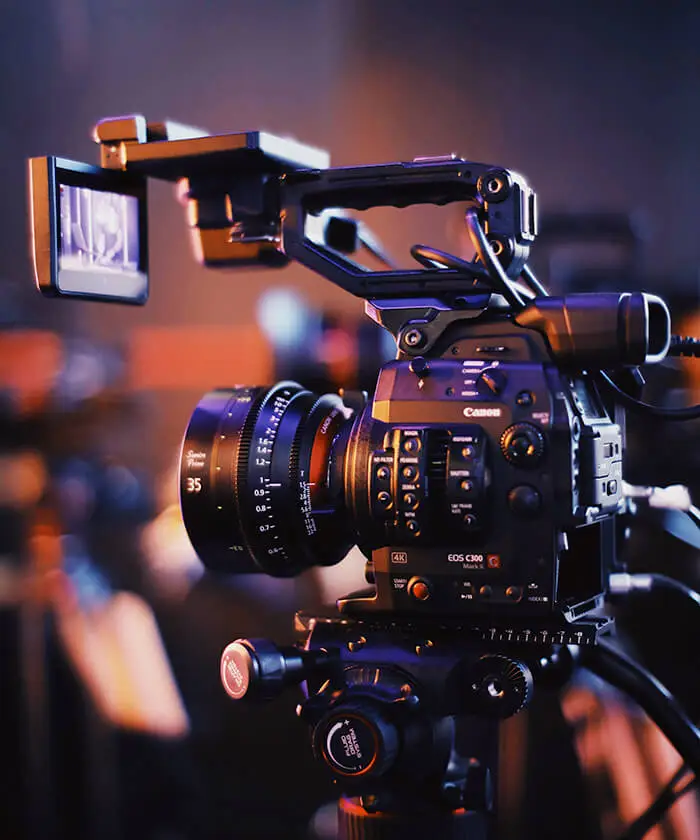Motion Graphic | Commercial Video
Photo & Design Studio
Commercial Video
Motion graphics are pieces of digital footage or animation which create the illusion of motion or rotation, and are usually combined with audio for use in multimedia projects. While any form of experimental or abstract animation can be called motion graphics, the term typically more explicitly refers to the commercial application of animation and effects to video, film, TV, and interactive applications.
Motion graphics extend beyond the most commonly used methods of frame-by-frame footage and animation. Motion graphics can be distinguished from typical animation in that they are not strictly character driven or story based and often represent animated abstract shapes and forms such as logos or logo elements. Since there is no universally accepted definition of motion graphics, the official beginning of the art form is disputed. There have been presentations that could be classified as motion graphics as early as the 1800s. Michael Betancourt wrote the first in depth historical survey of the field, arguing for its foundations in visual music and the historical abstract films of the 1920s by Walther Ruttmann, Hans Richter, Viking Eggeling and Oskar Fischinger.
Creating Jewelry Advertising Videos
(with out Without Model) for Commercial Use
The history of motion graphics is closely related to the history of Computer Graphics as the new developments of computer-generated graphics led to a wider use of motion design not based on optical film animation. The term motion graphics originated with digital video editing in computing, perhaps to keep pace with newer technology. Graphics for television were originally referred to as Broadcast Design.
Before computers were widely available, motion graphics were costly and time-consuming, limiting their use to high-budget filmmaking and television production. Computers began to be used as early as the late 1960s as super computers were capable of rendering crude graphics. John Whitney and Charles Csuri can be considered early pioneers of computer aided animation.
The term "motion graphics" was popularized by Trish and Chris Meyer's book about the use of Adobe After Effects, titled Creating Motion Graphics. This was the beginning of desktop applications which specialized in video production, but were not editing or 3D programs. These new programs collected together special effects, compositing, and color correction toolsets, and primarily came between edit and 3D in the production process. This "in-between" notion of motion graphics and the resulting style of animation is why sometimes it is referred to as 2.5D.
Creating Jewelry Advertising Videos
(with out Without Model) for Commercial Use
Motion graphics continue to evolve as an art form with the incorporation of sweeping camera paths and 3D elements.
Many motion graphics animators learn several 3D graphics packages for use according to each program's strengths. Although many trends in motion graphics tend to be based on a specific software's capabilities, the software is only a tool the broadcast designer uses while bringing the vision to life.
Leaning heavily from techniques such as the collage or the pastiche, motion graphics has begun to integrate many traditional animation techniques as well, including stop-motion animation, cel animation or a combination of both.
Elements of a motion graphics project can be animated by various means, depending on the capabilities of the software. These elements may be in the form of art, text, photos, and video clips, to name a few. The most popular form of animation is keyframing, in which properties of an object can be specified at certain points in time by setting a series of keyframes so that the properties of the object can be automatically altered (or twinned) in the frames between keyframes. Computers are capable of calculating and randomizing changes in imagery to create the illusion of motion and transformation. . These key poses or frames are commonly referred to as keyframes or low CP. Adobe Flash uses computer animation tweeting as well as frame-by-frame animation and video. Stop motion graphics is the oldest type of motion graphics which has given birth to cinemas, it provides unique effect to the videos.
Dynamic Advertising:
The Fusion of Motion Graphics and AI
In the ever-evolving world of advertising, the marriage of motion graphics and artificial intelligence (AI) has ushered in a new era of creativity, engagement, and personalization. This dynamic combination is revolutionizing how brands connect with their target audiences, leveraging the power of AI-driven motion graphics to craft compelling narratives and drive impactful marketing campaigns. In this article, we explore the synergy between motion graphics and AI and how it is reshaping the advertising industry.
The Power of Motion Graphics
Motion graphics are a versatile and visually captivating form of animation that brings static images and text to life. In advertising, they have been a staple for some time, offering a dynamic way to convey messages, showcase products, and tell stories. Motion graphics combine design, animation, and storytelling to create visually compelling content that resonates with viewers.
The Rise of AI in Advertising
Artificial intelligence has become a game-changer across industries, and advertising is no exception. AI-powered algorithms can analyze vast amounts of data, identify trends, and predict consumer behavior with remarkable accuracy. In the advertising sphere, AI is employed for targeted advertising, personalization, chatbots, and data-driven decision-making.
The Synergy Unleashed: AI-Driven Motion Graphics
- Personalization: AI can analyze user data and preferences to tailor motion graphics content in real-time. For instance, an e-commerce website can use AI to generate personalized product recommendation animations based on a user's browsing history and preferences.
- Dynamic Content: AI enables the creation of dynamic motion graphics that can adapt to changing circumstances. Weather-based advertising, for instance, can display different animations or messages based on current weather conditions in a user's location.
- Efficient Production: AI can streamline the motion graphics creation process by automating repetitive tasks. This allows designers and advertisers to focus on creativity and strategy rather than time-consuming manual work.
- A/B Testing: AI can help optimize motion graphics by conducting A/B testing on different elements such as colors, text, and animations to determine which versions perform best with specific audiences.
- Chatbots and Conversational Interfaces:
Motion graphics can be integrated with AI-powered chatbots to create interactive and engaging customer experiences. Users can receive information or assistance through animated chat interfaces.
- Predictive Analytics: AI can analyze user data to predict future trends and consumer behavior, allowing advertisers to proactively create motion graphics content that aligns with upcoming consumer interests.
The Impact on Advertising
The integration of AI-driven motion graphics in advertising offers several advantages:
- Higher Engagement: Personalized and dynamic content captures viewers' attention and keeps them engaged.
- Improved ROI: AI-driven targeting ensures that motion graphics are shown to the most relevant audience, leading to better conversion rates.
- Efficiency: Automated production processes save time and resources, making advertising campaigns more cost-effective.
- Data-Driven Insights: AI provides valuable insights into consumer behavior, allowing advertisers to refine their strategies continuously.
- Innovation: AI encourages creativity by automating routine tasks, allowing advertisers to focus on innovative storytelling and design.
The fusion of motion graphics and AI is reshaping the advertising landscape. It's no longer just about conveying a message; it's about delivering the right message, to the right audience, at the right time. AI-driven motion graphics are elevating advertising to new heights of personalization, engagement, and efficiency. As AI technology continues to evolve, we can expect even more innovative and impactful advertising campaigns that leverage the dynamic duo of motion graphics and AI to captivate audiences and drive business results. The future of advertising is dynamic, personalized, and AI-powered.





